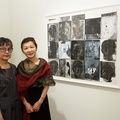I was born in Japan, but I crossed the ocean to Brazil when I was eight years old aboard a ship on which I spent 40 long days—very different from the 24-hour flights needed nowadays to make that same trip. When I disembarked on Brazilian soil, I found it strange to see all the different races, and I loved to eat loads of bananas, which, in Japan, were difficult to get because of the prohibitive prices back then.
I remember hating it whenever someone kissed my face or pinched my cheeks, saying, “Cutie.” Those were my first experiences of skin-on-skin contact, something I wasn’t used to.
During the first years, I went through an adaptation phase, learning the Portuguese language by way of Japanese. After that, I began to effectively take part in Brazilian society: I attended a local school, I was forced to communicate in Portuguese, and I began learning their habits and customs with the help of my Brazilian friends. I felt very sad whenever my friends called me “japonesinha” (“little Japanese girl”), especially because in those days “sashimi” didn’t have the same connotation it has today—it only meant those weird “slices of raw fish” that Asians ate.
For people like me—someone who is born in Japan, lives there the first eight years of her life, but grows up on the other side of the world—the issue of identity is a complex one. Even though they live within Brazilian society, they receive a Japanese education from their parents that, additionally, is based on customs in use when they lived in Japan. In other words, a temporal lapse is thus created. That is exactly why the Japanese in Brazil act more Japanese than those in Japan; that is, they’re more traditional.
The first time I returned to Japan, after twenty years of living in Brazil, I felt something very strange. At the time, I thought I was Japanese, especially considering that in Brazil everyone called me “little Japanese girl,” but then I discovered that I was not. When I saw the faces of the Japanese at the Shibuya intersection—all of them Japanese, no exceptions—I felt an indescribable strangeness. I had the same feeling when I got on a train and noticed that the Japanese didn’t look at anyone in the eye, as if the other passengers in that public transport didn’t exist. Theirs was the look of someone who doesn’t see but that, at the same time, is alert to everything, surreptitiously gathering information through the corner of the eye. That was quite a difference from the multiracial landscape where people look at one another, notice one another to the point of exchanging smiles—even with total strangers—that is found in Brazil. One only needs to notice the men following with their eyes, sometimes also whistling or calling, the sensual and beautiful women passing by.
The issue of belonging is complicated as well. Although one belongs to two cultures and two countries, speaking, reading, and writing in two languages, oftentimes one has the impression of not belonging to either one. It’s as if we were situated in a suspended space, in a space in between both cultures.
I’ve developed an academic study about the Ma, space, a time-space interstice of the where and when of Japanese culture. It is about an empty, interval and potential space whose origin is derived from the empty, cordoned space surrounded by pillars, where a divine presence was expected to appear. That characteristic is part of the way of thinking of the Japanese people; it is found in their day-to-day activities, such as in the manner that communication is established; be it in the oral language represented by silence, be it in gestures as in their way of greeting one another. Neither the silence, the pause found in Japanese speech, nor the void that is created has a negative connotation; in other words, neither one represents the nothingness akin to the zero of death; instead, they are akin to the zero of birth. Therefore, they carry the possibility of everything happening.
The ideogram Ma, a sun between two little doors, has the semantics of the in-between space and is contained in commonplace expressions, such as Manuke (Ma + nukeru, to lack), which means someone missing Ma, that is, a silly or stupid person.
It’s not by chance that in my condition of jun-nissei (those born in Japan but who have left the country before completing their basic education) I feel myself exactly in the Ma space between Brazil and Japan. To find oneself in that intermediary space may constitute a problem for some, but in my view it is a privilege to inhabit that intersection between two such disparate cultures and to be able to choose, according to the circumstances, different ways of thinking and acting.
Another way of finding comfort for those who inhabit that interval space is to go beyond the bipolarity created between Brazil and Japan so as to obtain at least triadic, at best multifaceted, references. To encompass multiple ways of seeing things and to be able to have various points of view may well be something both interesting and necessary in the globalized world in which we live.
When it comes to my questions vis-à-vis identity and belonging, nowadays the issue of the homogeneity of Japanese faces in Japan, notwithstanding the mix that can be currently witnessed, and the vague look of those unable to see others don’t frighten me anymore; let alone the little kisses on the cheek and the warm hugs exchanged among Brazilians. I no longer face exclusion, “one or the other”; instead, I experience addition, “one and the other,” something that space is capable of offering.
© 2009 Michiko Okano



